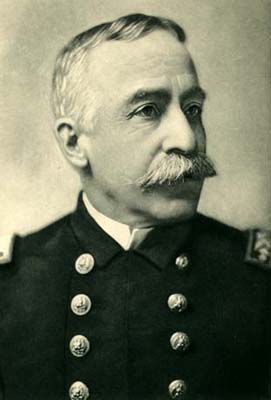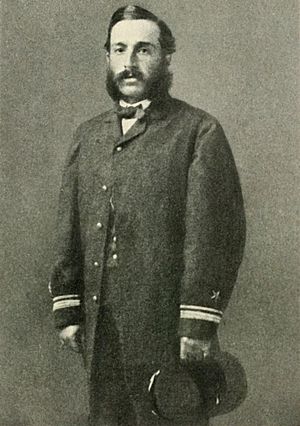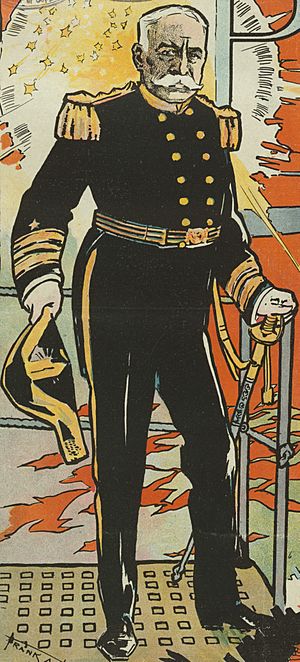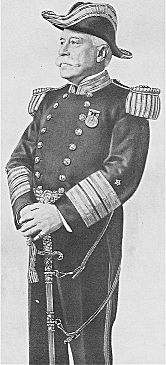George Dewey facts for kids
Quick facts for kids
Admiral of the Navy
George Dewey
|
|
|---|---|
 |
|
| Born | December 26, 1837 Montpelier, Vermont |
| Died | January 16, 1917 (aged 79) Washington, D.C. |
| Buried | |
| Allegiance | Union |
| Service/ |
|
| Years of service | 1858–1917 |
| Rank | |
| Commands held | Asiatic Squadron General Board of the United States Navy |
| Battles/wars | American Civil War
|
| Alma mater | United States Naval Academy |
| Signature |  |
George Dewey (December 26, 1837 – January 16, 1917) was a famous American naval officer. He holds a special place in history as the only person to ever reach the rank of Admiral of the Navy in the United States! He is most famous for his amazing victory at the Battle of Manila Bay during the Spanish–American War. In this battle, his fleet won with almost no American casualties.
Dewey was born in Montpelier, Vermont. He joined the United States Naval Academy in 1854. After graduating in 1858, he became an officer on the USS Mississippi. He fought in the American Civil War, helping the Union gain control of the Mississippi River. By the end of the war, he was a lieutenant commander.
After the Civil War, Dewey had many different jobs in the Navy. He served on several ships, including the historic USS Constitution. He also taught at the Naval Academy. In 1896, he became a commodore and was put in charge of the Asiatic Squadron. This was just before the war with Spain began in 1898.
When the war started, Dewey quickly led his fleet to Manila Bay. He sank the entire Spanish Pacific fleet with very few losses for the Americans. This victory made him a national hero. He was promoted to Admiral of the Navy in 1903. He continued to serve on the General Board of the United States Navy, which helped make important decisions for the Navy, until he passed away in 1917.
Contents
Early Life and Education
George Dewey was born in Montpelier, Vermont, on December 26, 1837. His father, Julius Yemans Dewey, was a doctor and helped start the National Life Insurance Company. George had two older brothers and a younger sister. He was baptized and went to Sunday school at Christ Episcopal Church in Montpelier.
He attended school in Johnson, Vermont. When he was fifteen, he went to Norwich Military School, now known as Norwich University. He studied there for two years (1852–1854). He later entered the United States Naval Academy in 1854 at age 16.
The Naval Academy had just started its four-year program in 1851. There were only about 100 students, called Acting Midshipmen. Out of all the students who started with Dewey, only fourteen finished the course. He graduated on June 18, 1858, ranking fifth in his class.
First Sea Voyages
As a midshipman, Dewey's first trip was on the USS Saratoga. He did so well that he was assigned to the USS Wabash, a large steam frigate. This ship was the main vessel of the Mediterranean Squadron. On July 22, 1858, the Wabash sailed from Hampton Roads to Europe.
The Wabash traveled around the Mediterranean. Dewey and the other young officers visited many old cities. Dewey was in charge of keeping the ship's logbook. The Wabash returned to the New York Navy Yard in December 1859. Dewey also served on two shorter trips in 1860.
Civil War Service
When the American Civil War began, Dewey was an executive lieutenant on the USS Mississippi. This ship was part of the Union's West Gulf Blockading Squadron.
Attack on New Orleans
In early 1862, the Mississippi joined David Farragut's fleet to capture New Orleans. On the night of April 24–25, 1862, Farragut led his ships up the Mississippi River. They had to pass the Confederate forts, Fort St. Philip and Fort Jackson. Dewey was at the helm of the Mississippi, which was the third ship in Farragut's first group.
The large Union ships stayed close to the west bank where the water was deeper. This meant they were right under the enemy guns. Dewey skillfully steered the Mississippi through shallow water.
Confederate gunboats were waiting above the forts. One was the CSS Manassas, a small ironclad ship. The Manassas tried to ram the Mississippi, but Dewey avoided it. Farragut then ordered the Mississippi to chase the Manassas. Dewey steered his ship to ram it. The Manassas dodged but ran aground and was abandoned. The Union forces set it on fire.
Farragut's fleet continued upriver and made New Orleans surrender. This battle was the first time Dewey showed his bravery and skill. For the rest of 1862, his ship patrolled the lower river, facing attacks from Confederate sharpshooters.
Battle of Port Hudson
In the spring of 1863, Union forces tried to capture the Confederate fortress at Port Hudson, Louisiana. This fort was important because it was where the Red River joined the Mississippi. Farragut wanted to pass the fort with his fleet and cut it off.
On March 14, 1863, the Union fleet made its attempt. Dewey saw some of the fiercest fighting of his career. The Mississippi ran aground and was hit by heavy enemy fire for half an hour. The crew had to abandon the ship. Dewey was one of the last people to leave the sinking vessel.
Later Civil War Service
Dewey was praised for his courage. He was made executive officer of the USS Agawam, a small gunboat. This ship was often under fire from hidden sharpshooters. In July, during a small battle, Dewey showed such bravery that he was recommended for promotion.
Later in 1864, Lieutenant Dewey became executive officer of the USS Colorado. This ship was part of the North Atlantic Blockading Squadron.
Battles of Fort Fisher
By late 1864, Wilmington, North Carolina, was the last port open to the Confederacy. It was protected by Fort Fisher. A joint Army-Navy attack in December 1864 failed.
A second attack happened in January 1865. The Colorado was involved, and Dewey played a key part in its success. Even though the Colorado was a wooden ship, it fought bravely. Admiral Porter ordered the Colorado to move closer and silence a part of the fort. Despite the ship already being damaged, Dewey quickly saw the advantage. The fort section was taken in fifteen minutes. This action was called "the most beautiful duel of the war." Dewey was promoted to lieutenant commander.
After the Civil War
After the Civil War, Lieutenant Commander Dewey stayed in the Navy. He was sent to Europe as executive officer of the USS Kearsarge. This ship was famous for sinking the Confederate privateer Alabama.
Peacetime Duties
From 1867 to 1868, Dewey was executive officer of the USS Colorado again. This ship was the main vessel of the European Squadron. From 1868 to 1870, he taught at the Naval Academy. He also commanded the famous frigate USS Constitution, which was used for training.
For nearly four years, Dewey commanded the USS Narragansett. He spent this time surveying the Pacific Coast.
Lighthouse Board and Promotions
In 1880, Dewey was assigned to Washington, D.C.. He became a lighthouse inspector and then secretary of the lighthouse board. He found this work very interesting. During this time, he was promoted to commander. Living in Washington, he became well-known and popular.
In 1882, he was sent to the Asiatic station in command of the USS Juniata. He learned a lot about the region, which would be very important years later.
He was promoted to captain in 1884. He then commanded the USS Dolphin, one of the first modern steel-hulled ships of the U.S. Navy. The Dolphin was often used as the Presidential yacht.
From 1885 to 1888, Captain Dewey commanded the USS Pensacola, the main ship of the European squadron. In 1896, he was promoted to commodore.
Spanish–American War Victory

In 1896, Dewey asked to be put in charge of the Asiatic Squadron. His friend Theodore Roosevelt helped him get the position. Dewey took command of the USS Olympia in January 1898. He then sailed to Hong Kong to check on U.S. warships there. While in Hong Kong, he learned that the Maine had exploded in Havana Harbor.
Dewey prepared his squadron for a possible war with Spain. He bought two merchant ships, the Nanshan and the Zafiro. He also had the warships repainted from white to gray. When war broke out, the United Kingdom declared its neutrality, so Dewey moved his squadron to Mirs Bay in China.
Battle of Manila Bay
On April 27, 1898, Dewey sailed from China on the USS Olympia. His orders were to attack the Spanish fleet at Manila Bay. He arrived at the bay's entrance late on April 30. The next morning, he gave the famous order to attack: "You may fire when you are ready, Gridley."
Dewey defeated the Spanish in a battle that lasted only six hours. His Asiatic Squadron sank or captured the entire Spanish Pacific Squadron. They also silenced the shore batteries at Manila. The amazing part was that only one American sailor died during the battle!
After this huge victory, Dewey's fleet helped the U.S. Army capture Manila.
Role in the Philippines
In the early part of the war in the Philippines, Dewey and the Americans worked with Filipino nationalists. These Filipinos were led by Emilio Aguinaldo. They had been fighting the Spanish on land. Dewey and Aguinaldo had a good relationship at first. Dewey even wrote that Filipinos were "intelligent" and "capable of self-government."
In August 1898, after U.S. Army troops arrived, Dewey helped General Wesley Merritt take control of Manila. This was called the "mock Battle of Manila." Aguinaldo's troops, who had surrounded Manila, were kept out of the city. In February 1899, the Philippine–American War began.
A National Hero
Dewey was promoted to rear admiral in May 1898, and then to full admiral the next year. When he returned to the United States on September 27, 1899, he received a hero's welcome. New York City held a two-day parade to celebrate him. In Boston, singers greeted him with "See the Conquering Hero Comes."
In 1903, Congress promoted him to the special rank of Admiral of the Navy. This rank was made retroactive to 1899. He is the only person in U.S. history to ever hold this rank.
A special medal, the Battle of Manila Bay Medal (also called the Dewey Medal), was created to honor his victory. Every American officer, sailor, and Marine at the battle received one. The medals were designed by Daniel Chester French, who also sculpted the Lincoln Memorial. Because his own image was on the front of the medal, Dewey humbly wore his medal with the back showing.
On October 3, 1899, President McKinley gave Dewey a special sword at the Capitol building. Congress had voted to spend $10,000 on this gift. The sword was custom-made by Tiffany & Co. and had parts made of 22-carat gold. This sword, along with Dewey's uniforms and medals, is now on display at the National Museum of the United States Navy in Washington.
Later Life and Legacy
Many people suggested Dewey run for President in 1900. However, he made some comments that caused criticism. He said the job of president would be easy and that he had never even voted in a presidential election. He also angered some people when he married a Catholic woman and gave her the house that the nation had given him. Dewey eventually withdrew from the race and supported President William McKinley.
In 1900, he became president of the new General Board of the Navy Department. This board was important for making Navy policy. He stayed on this board until his death. He strongly supported bringing new technologies, like naval aviation and submarines, into the growing U.S. Navy.
Family Life
In 1866, Dewey met Susan "Susie" Boardman Goodwin (1844–1872). They married on October 24, 1867, and had one son, George. Sadly, Susie died on December 28, 1872, shortly after giving birth.
On November 9, 1899, Dewey married for a second time to Mildred McLean Hazen (1850–1931). She was the widow of General William Babcock Hazen. Their wedding took place in a rectory because Mildred was Catholic and George was not.
Admiral Dewey passed away in Washington on January 16, 1917. After his body lay in state at the United States Capitol rotunda, he was buried at Arlington National Cemetery. Later, his remains were moved to the Bethlehem Chapel at the Washington National Cathedral.
Memberships and Honors
Admiral Dewey belonged to many military and patriotic groups. He was an honorary member of the New York Society of the Cincinnati in 1901. He was also a key leader in the Naval Order of the United States.
His membership badges for most of these groups are kept at the National Museum of the United States Navy. Dewey was also an early board member of the Boy Scouts of America.
Dates of Rank
- Acting Midshipman, United States Naval Academy: September 23, 1854
- Warranted Midshipman: June 11, 1858
- Passed Midshipman: January 19, 1861
- Master: February 28, 1861
- Lieutenant: April 19, 1861
- Lieutenant commander: March 3, 1865
- Commander: April 13, 1872
- Captain: September 27, 1884 (Retroactive to July 28, 1884)
- Commodore: February 28, 1896
- Rear admiral: May 11, 1898
- Admiral: March 8, 1899
- Admiral of the Navy: March 24, 1903 (Retroactive to March 2, 1899)
Admiral Dewey's final rank was Admiral of the Navy. He is the only person to ever hold this rank, making him the highest-ranking officer in U.S. Navy history. He served a total of 62 years on active duty!
Medals Awarded by the U.S. Government
- Civil War Campaign Medal (1908)
- Battle of Manila Bay Medal (also known as the "Dewey Medal") (1899)
- Spanish Campaign Medal (1908)
- Philippine Campaign Medal (1908)
Dewey wore the Battle of Manila Bay Medal with the back showing because his own face was on the front. He was one of only four officers in American military history allowed to wear a medal with their own image on it.
Namesakes and Legacy
Many places and things have been named after Admiral George Dewey to honor him:
- Dewey International Elementary School in Saint Louis, Missouri.
- Dewey Point in Yosemite National Park, California.
- Dewey Hall at Norwich University, built in 1899.
- Dewey Fire Company No. 1 in Hellertown, Pennsylvania, formed in 1898.
- Dewey Square in Boston, Massachusetts.
- Four United States Navy ships have been named Dewey, including the Arleigh Burke-class destroyer Dewey.
- Dewey Hall and Dewey Field at the United States Naval Academy in Annapolis, Maryland.
- Dewey Field at Naval Station Newport in Newport, Rhode Island.
- Dewey City, a subdivision in Thomasville, Georgia.
- The column in the center of San Francisco's Union Square is dedicated to Dewey's victory.
- Dewey Beach, Delaware.
- Dewey Street in St. Paul, Minnesota.
- Dewey Avenue in Norman, Oklahoma.
- City of Dewey, Oklahoma.
- Dewey County, Oklahoma.
- The main town of Culebra, Puerto Rico, was named in his honor.
- The Dewey School in Castle Rock, Colorado.
- Dewey Avenue in Wharton, New Jersey.
- Dewey Blvd, now Roxas Blvd, a major road in Manila, Philippines.
- George Dewey High School at the former U.S. Naval Base Subic Bay in the Philippines.
- Deweyville, a settlement in Newton County, Texas.
- Dewey Lake in St. Louis County, Minnesota.
- The tugboat Admiral Dewey.
- Dewey Road at the former San Diego Naval Training Center.
- Dewey-Humboldt, Arizona.
- George Dewey Elementary School in San Diego, California.
- The World War II Liberty Ship SS George Dewey.
- George Dewey Medical and Wellness Center, Morong, Bataan Philippines.
- The Admiral Dewey March, a patriotic song.
- Admiral Dewey's service sword is on display in the wardroom of the USS Dewey (DDG-105).
Images for kids
See also
 In Spanish: George Dewey para niños
In Spanish: George Dewey para niños






